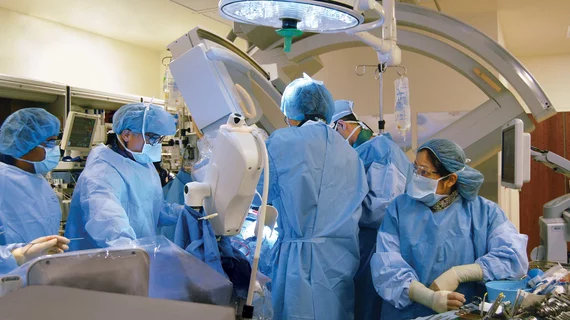Is TAVR too common among younger, low-risk patients? 2 experts share their concerns
Transcatheter aortic valve replacement (TAVR) has gained considerable momentum in recent years as a treatment option for symptomatic severe aortic stenosis (AS), even among younger, low-risk patients.
Is it possible that cardiologists and other members of the heart team are starting to lean on TAVR too much? Would some of these low-risk patients be a better fit for surgical aortic valve replacement (SAVR) instead of TAVR?
Two longtime structural heart disease specialists with Houston Methodist Hospital (HMH) asked those very questions in a new commentary piece published in JAMA Cardiology.[1]
“Data from the Vizient Database for 2015 to 2021 show that among 17,487 patients younger than 65 years, TAVR use increased 2.7-fold such that in 2021, 47.5% of cases were TAVR and 52.5% were SAVR,” wrote co-authors Sachin S. Goel, MD, an interventional cardiologist, and Michael J. Reardon, MD, a cardiac surgeon and Alison Family Distinguished Chair of Cardiovascular Research, both at the Houston Methodist DeBakey Heart & Vascular Center. “We should ask, however, if this indication creep for TAVR in younger, low-risk patients is based on the data or just the desire (of both patients and physicians) for TAVR.”
Key points to remember about TAVR in younger, low-risk patients
Goel and Reardon wrote that many of the biggest, most influential TAVR trials excluded patients for a number of reasons. Patients were excluded if they required additional cardiac surgery, for example, or if they presented with a significant amount of coronary artery disease.
Modern SAVR trials, however, have typically included patients who fell into those categories—and they were associated with clinical outcomes that were generally positive.
In addition, the two authors wrote, the American Heart Association and American College of Cardiology still recommend that patients younger than 65 years old with an expected survival rate of 20 years be treated with SAVR over TAVR.
So why, exactly, are more and more younger patients now being treated with TAVR? Goel and Reardon shared their concerns.
“Performing TAVR in this population raises questions related to lifetime management, coronary access, valve durability, and feasibility of repeat TAVR vs TAVR explant and SAVR,” the two authors wrote. “The use of TAVR for those younger than 65 years with anatomy suitable for SAVR and expected survival for age remains a knowledge gap that has yet to be adequately studied.”
Goel and Reardon also noted that the PARTNER 3 and Evolut trials both required heart teams to run all TAVR candidates by a national screening committee for final approval. In both instances, the committee turned down a significant number of requests, saying that the patient would be better off undergoing SAVR than TAVR. This detail, the two authors explained, should be something that all cardiologists consider when using those trials to guide their decisions.
“This disparity between the local heart team’s decision and that of the national committee suggests that these cases were highly selected and thus the results were likely not applicable to all low-risk cases,” they wrote.
Another key takeaway from the duo’s commentary was that most data on TAVR valve durability is focused on older patients who are more typically seen as ideal candidates for this procedure. Until more time has passed and researchers can examine long-term follow-up data on younger patients, the durability of these valves in that specific patient population remains yet another unknown.
The duo concluded by emphasizing that they are still 100% in favor of TAVR when it truly seems like the best treatment option.
“We are advocates for TAVR in appropriate cases,” the two authors wrote. “We urge our colleagues to consider and hopefully fill existing knowledge gaps to allow the continued rational expansion of indications for TAVR based on data that can support desire.”
Read the full commentary here.

